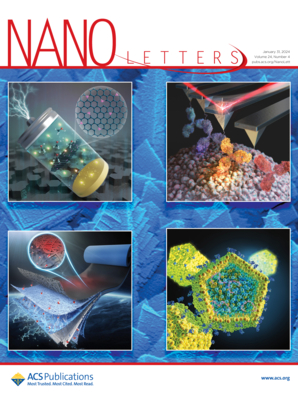单层单层石墨烯复合材料纳米钢筋的增韧机理研究
IF 9.6
1区 材料科学
Q1 CHEMISTRY, MULTIDISCIPLINARY
引用次数: 0
摘要
石墨烯的固有强度为100 GPa,有望应用于装甲领域。然而,热力学上有利的制造缺陷严重地降低了它们的可实现强度。为了解决这个问题,研究人员研究了夹在石墨烯单层之间的一维纳米钢筋。在扫描电镜下研究了增强石墨烯的实时i型裂纹扩展阻力,结果表明,一维和二维纳米材料之间的耗散相互作用可以使石墨烯的延展性提高100%以上,但有效韧性有轻微损失。通过引入几何整合的概念来解释它们之间的载荷传递,分析了这一显著的改进。通过有限元分析和剪切滞后模型,我们解释了纳米钢筋和石墨烯之间的耗散相互作用在减少裂缝周围的应力集中,从而获得高延性方面的贡献。耗散键在维持较低的界面应力方面比共价键更有利,进一步延缓了界面局部破坏。本文章由计算机程序翻译,如有差异,请以英文原文为准。

Toughening Mechanisms in Stacked Bilayer Graphene Sheets by Means of Sandwiched 1D Nano-rebars
Graphene, with an intrinsic strength of >100 GPa, exhibits promise for armor applications. However, the thermodynamically favorable manufacturing defects severely diminish their achievable strength. To remedy this, 1D nano-rebars, sandwiched between graphene monolayers, were studied. Real-time mode-I crack growth resistance was studied in reinforced graphene under SEM, which revealed that the dissipative interactions between 1D and 2D nanomaterials can increase the ductility of graphene by over 100%, albeit at a slight loss in effective toughness. This significant improvement was analyzed by introducing the concept of geometric conformity to explain the load transfer between them. By means of finite element analysis and shear lag models we explained the contribution of dissipative interactions between nano-rebar and graphene in reducing stress concentration around cracks, leading to high ductility. The dissipative bonds were found to be more favorable over covalent bonds in terms of maintaining a lower interface stress, further delaying interface local failure.
求助全文
通过发布文献求助,成功后即可免费获取论文全文。
去求助
来源期刊

Nano Letters
工程技术-材料科学:综合
CiteScore
16.80
自引率
2.80%
发文量
1182
审稿时长
1.4 months
期刊介绍:
Nano Letters serves as a dynamic platform for promptly disseminating original results in fundamental, applied, and emerging research across all facets of nanoscience and nanotechnology. A pivotal criterion for inclusion within Nano Letters is the convergence of at least two different areas or disciplines, ensuring a rich interdisciplinary scope. The journal is dedicated to fostering exploration in diverse areas, including:
- Experimental and theoretical findings on physical, chemical, and biological phenomena at the nanoscale
- Synthesis, characterization, and processing of organic, inorganic, polymer, and hybrid nanomaterials through physical, chemical, and biological methodologies
- Modeling and simulation of synthetic, assembly, and interaction processes
- Realization of integrated nanostructures and nano-engineered devices exhibiting advanced performance
- Applications of nanoscale materials in living and environmental systems
Nano Letters is committed to advancing and showcasing groundbreaking research that intersects various domains, fostering innovation and collaboration in the ever-evolving field of nanoscience and nanotechnology.
 求助内容:
求助内容: 应助结果提醒方式:
应助结果提醒方式:


